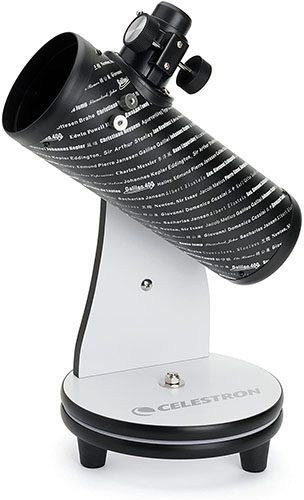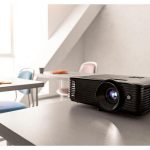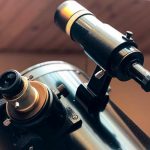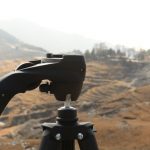7 Best Beginner Telescopes For Under $100 in 2020
Most newcomers to astronomy want to know the best beginner telescopes for under $100 because buying a telescope is no simple task.
There are thousands of different telescopes to choose from. If your first choice is a disaster, then it may even put you off astronomy for life. No-one expects NASA quality moon pictures from a telescope under $100 with a 70mm telescope, so what can you see for your money?
What Can You See on a Clear Night with Best Telescopes Under 100$
Within The Solar System:
- The moon and its craters
- The rilles of the moon
- Planet Mercury phases
- Planet Mars polar caps
- The dark surface of planet Mars
- Cloud belts on planet Jupiter
- Planet Jupiter’s moons and shadows
- Planet Saturn’s and about 4-5 of Saturn’s moons
- Sunspots (using an aperture filter)
- Planets Neptune and Uranus (not clear)
Stars and Nebulas:
- Some double stars
- Stars with about 11.5 to 12 stellar magnitude
- Emission nebulas
- Globular clusters
- Distant galaxies
- Planetary nebulas, etc.

Our Top 7 Telescopes Under 100$
- Meade Instruments-Infinity 70mm Aperture
- Meade Instruments-Infinity 80mm Aperture
- Gskyer Telescope 70mm Aperture Refracting Telescope
- Orion 10012 SkyScanner 100mm TableTop Reflector Telescope
- Celestron 21024 FirstScope Telescope
- Celestron – PowerSeeker 80EQ Telescope
- Orion SpaceProbe II 76mm Equatorial Reflector Telescope Kit
Telescopes can be very expensive when you don’t have a great deal of knowledge about them, and it’s difficult to know which one is the best one for your budget.
This puts many people off even getting started for fear of wasting their money on a telescope that just doesn’t cut it. But we have to tell you this, it’s not always the telescope’s fault. Even the best telescopes for viewing galaxies will not work for you if you don’t know where they are in the sky.
Astronomy is not simply looking in the night sky. If you learn the constellations and study detailed sky maps, you have some great stargazing that will keep you happy and busy for years.
That’s why we’ve put together the 7 best beginner telescopes for under $100 to give you a better idea of the quality telescope kit you can get for under that amount.
Best Choice Beginner Telescopes Under $100
Meade Instruments-Infinity 70mm Aperture – Best Beginner Telescope For The Money
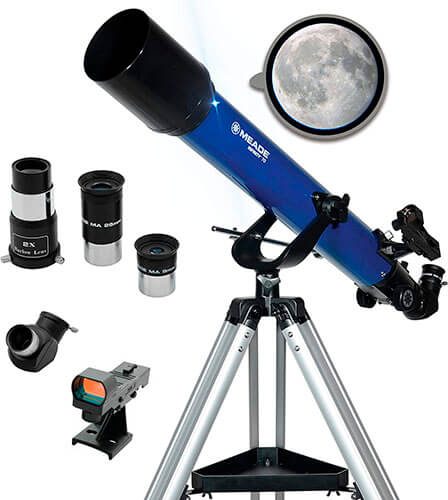
You will be able to view deep space and the solar system with the Meade Instruments 70mm telescope, but around this aperture size is the bare minimum you require. However, it’s the best telescope for under $100 on the market today.
If you’re a beginner and new to astronomy, then the Meade 70mm is the best telescope to see planets and stars at this price point. In fact, it might surprise you at just what you will see, such as the moons around Jupiter and Saturn’s rings, even Mars is visible, albeit only a red dot.
If it interests, you can see the Apollo landing site on the moon very clearly with this telescope.
With an aperture of only 70mm, deep space is not clearly visible, but bright objects you can see. For example, you can definitely see Orion Nebula and the Andromeda Galaxy.
The eyepieces that come as standard with the telescope are above average for this price of a telescope. The 26mm gives 27x magnification, and the 9mm gives 78x. There’s a good chance after you go down the road with this telescope you’ll splash out on some newer, better quality eyepieces. In fact, this is usual with all cheaper telescope makes.
As usual, the tripod that packs with this price telescope is not as stable as it could be. If you’re at high magnifications, the slightest movement can really upset your viewing.
The alt-azimuth mount does a good job moving through horizontal, but vertically it’s nowhere near as smooth.
The Meade 70mm comes with some very useful accessories. For example, the eyepieces are not too bad and include a red dot finder, which is a plus. The focuser is also a nice accessory that works well and is easy to operate.
There’s a Barlow lens included in the pack, which will double the magnification of the eyepieces. But as we mentioned earlier, you will want to upgrade your eyepieces anyway, which is a better way to achieve magnification.
The Meade Instruments 70mm is the best beginner telescope, available at this price and beats off any competition.
What we like / don’t like about the Meade Instruments-Infinity 70mm Aperture
- Price point
- Excellent accessories
- Decent eyepieces
- Easy to use the focuser
- Ease of setup
- Decent images for a beginner telescope
- Tripod not stable enough
- Alt-azimuth could be smoother
Meade Instruments-Infinity 80mm Aperture – Best High-end Telescope For Beginners Under $100

The price the Meade Instruments Infinity 80mm a little over the $100 price point, but well worth adding it to our list of best beginner telescopes. Even though over the $100 it’s the best candidate as the cheapest professional tripod-mounted telescope for entry-level astronomers.
The aperture is 80mm, which is the minimum size if you’re looking to get into deep-sky observation.
Meade’s Infinity 80 optical tube is the best grab and go telescope in this price range, and we believe the Infinity 80 is the best 80mm f/5 available at this time.
Made for wide fields and low magnification it suits deep-sky observation more than moon and planets viewing. They can still be observed, but not as clearly. The fun you get with this telescope is viewing the Milky Way and looking at star clusters and nebulae.
Inclusive accessories such as a Red-Dot Viewfinder, 2x Barlow Lens (to double the magnification of the eyepieces), and 3 Eyepieces a 26mm MA (15x), 9mm MA (44x) and a 6.3mm MA (63x) providing varying levels of magnification, giving you versatility over short and long-range distances.
If you enjoy terrestrial viewing, then you’ll like the added accessory of a 90-degree erect-image prism. The purpose of this is to ensure images are upright when you view them through the lens. For the money, it’s the best telescope for terrestrial and celestial viewing.
Mount and Tripod
- Manual alt-azimuth
- Flex-arm controllers
- 1.25″ steel tube legs
- 33″ to 51″ height range
Included along with the accessories is a DVD with over 10,000 celestial objects perfect for beginners. It’s only useful if you have a Windows PC.
What we like / don’t like about the Meade Instruments-Infinity 80mm Aperture
- Decent optics
- Grab and Go
- Good for land and sky
- 3 eyepieces
- Solid tripod
- Controls operate in slow motion to view fast-moving objects
- Price point
- Excellent beginner’s telescope
- Some flimsy accessories
- Limited planetary viewing
- Some chromatic aberration
Gskyer Telescope 70mm Aperture Refracting Telescope – Best Beginner Telescope For Under $100
Getting into any new hobby or interest can be tough enough, without having to spend hours figuring out the equipment you need to use. Telescopes by their nature can be complicated beasts, with confusing accessories and features the handbook forgets to mention.
So when you find the best grab and go telescope it’s an automatic winner.
The Gskyer 70mm aperture refracting telescope gets our vote for the best telescope for under $100 because it’s simple to use, a high quality, portable and small refractor telescope.
With the quality of its fосаl ѕресifications and ассеѕѕоrіеѕ, уоu’ll bе аblе tо check out thе mооn, іnсludіng the moon’s сrаtеrѕ, other рlаnеtѕ, сlоud bаndѕ, Јuріtеr’ѕ mооnѕ, аnd Ѕаturn’ѕ rіngѕ. Not bad for a beginner stargazer telescope, you’ll be feeling proud of yourself in no time.
Тhе Gѕkуеr hаѕ nice орtісѕ with ѕlіghtlу lоngеr fосаl lеngth thаn comparable tеlеѕсореѕ in a similar price band. Аѕ а rеfrасtіng tеlеѕсоре, the lеnѕеѕ are mаdе frоm glаѕѕ and fullу соаtеd wіth аntі-rеflесtіvе соаtіngѕ.
There are also many accessories included in the telescope kit. Included are two eyepieces, one 25mm for 16x magnification and a 10mm for 40x magnification. To make the magnification more powerful, there is a 3x Barlow lens to triple the power of each of the eyepieces.
To help you find the objects in the sky, there is a 5 x 24 finder scope with mounting bracket and crosshairs.
Sometimes when you find something interesting, you might want to share it. That’s made possible by the addition to the kit of a smartphone adapter and wireless camera remote.
We wouldn’t call the Gskyer the best terrestrial telescope, but it includes what they term as a zenith mirror, set at 48 degrees. So you can use it for terrestrial viewing.
What we like / don’t like about the Gskyer Telescope 70mm Aperture
- Sturdy
- Wireless remote
- Finderscope
- Replaceable eyepieces
- Smartphone adapter
- Ease of assembly
- No instruction manual
- No eyecups to block stray light
Orion 10012 SkyScanner 100mm TableTop Reflector Telescope – Best Value For Money Beginners Telescope
The Orion SkyScanner 100mm Tabletop Reflector Telescope is a nice beginner’s scope and one of the cheapest telescopes you will find equipped with a real parabolic mirror.
A tabletop on a Dobsonian mount, and with a small, lightweight design, makes it an excellent candidate for the best portable mini telescope for around $100. It might look small, it’s definitely not a toy telescope, but it would make a great first telescope for kids, weighing in at only 6.2 pounds.
There’s no assembly required, simply attach the finder and you’re ready to go. One negative about the telescope is the primary mirror is pre-collimated (made accurately parallel) by the factory. This is OK as long as the scope doesn’t get banged around too much in transit. If it does, there’s a chance it may get knocked out of collimation.
Most scopes under $100 have a spherical mirror, but the Skyscanner has a parabolic mirror, giving it far better viewing abilities. This is the make or break point of any telescope, how clear the images are.
It’s designed for a tabletop, but you can place it wherever you like, providing the platform has no movement. The mount has up-and-down and side-to-side movement or alt-azimuth. If you wanted to use it as a camping telescope then there is 3/8 tripod connection underneath the base.
To get different mounting options in a budget telescope is unusual, but very useful.
The telescope has two eyepieces, 20mm and 10mm. When using the SkyScanner 100mm, begin with the 20mm eyepiece, giving you a wider view. Once you’ve centered the object you’re searching for, boost the magnification up to 40x by switching out the lens to the 10mm eyepiece. Using both eyepieces gives you different magnifications when you stargaze. As your experience grows, you can use other 1.25″ eyepieces.
The position of focuser, finderscope, and dovetail is not that practical. With the eyepiece on the top of the telescope, it’s a touch uncomfortable for tabletop viewing. Using a tripod will position the viewer to the side, which is much better.
If you’re thinking about any extra accessories, a quality 2.5 or 3 x Barlow lens would add some extra dimension to your close-up views of planets and the moon’s surface. Another idea is to buy a 25mm Plossl eyepiece to give you a 3 degrees wide view, with that you will see nearly all the Andromeda galaxy.
What we like / don’t like about the Orion 10012 SkyScanner 100mm TableTop Reflector Telescope
- Good Optics
- Versatile mounting
- Robust build quality
- Price point
- 1-year warranty
- Significant looks
- Portable telescope
- Quality accessories
- Bad focuser placement
- Primary mirror pre-collimated
Celestron 21024 FirstScope Telescope – Best Beginner Telescope For Kids For Under $100
The Celestron FirstScope is the best kid’s telescope for under $50. If you’re looking for a first telescope for your kids, then this is the one that doesn’t break the bank account.
Kids can be flaky with their interests and sometimes flit from one to another, so good to test interest levels over time, with a cheap telescope.
It’s a portable tabletop design and very lightweight, only 4lbs, for a child in a hurry a good grab and go telescope. The FirstScope will provide some delightful views of the planets and the moon’s surface. Enough to see if it’s going to be a lasting interest, at least.
For this price, you will not see sharp images above 40 x magnification. There’s also no finderscope, which means sighting down the tube using the 20mm (40x magnification) eyepiece.
They’re ready to go straight out of the box, just add the eyepiece. A real bonus if your child is excited about viewing instantly.
Collimation might be a little tricky because you cannot adjust the primary mirror.
The FirstScope will not pick out clear images, but it will find solar planets like Venus and Saturn. The moon won’t deliver up any secrets either, because you cannot get close-ups, but you can see the craters.
As we mentioned it really is the first telescope at a budget price to give kids a glimpse of what could be possible. If they love what they see and want to become better astronomers, then might be the time to invest in a more upmarket model.
What we like / don’t like about the Orion 10012 SkyScanner 100mm TableTop Reflector Telescope
- Cheap price
- Durable
- Ease of use
- Ready out of the box
- Nice looking
- Portability
- Grab and go
- No instructions
- Optics are not good
- Extra cost for better accessories
- No finderscope
Celestron – PowerSeeker 80EQ Telescope – Best Portable Beginner Telescope Under $100
The Celestron PowerSeeker 80EQ is a refractor telescope with an 80mm aperture and sitting bang in the middle of the Celestron PowerSeeker range. Where it sits in the middle of the range shows how to view buying the telescope. It’s a fair balance between power and price.
It’s not bad optically and performs reasonably viewing the Moon, planets, and double stars. It has a decent tube. However, it falls way short with the finderscope, and you’ll quickly want to buy a better one.
There are a 1.25-inch metal rack and pinion focuser. If you buy a quality finderscope, you’ll find the focuser has a slot allowing you to attach a different finderscope or red dot sight.
The most important accessories are the two eyepieces. A 20mm (45x) Kellner and a 4mm (225x) Ramsden. The 20mm Kellner does OK, but the Ramsden really isn’t worth the time of day. There’s also a 3x Barlow lens, an aluminum tripod and SkyX software. The software really helps beginners to pinpoint where they need to be looking.
The 80EQ is equipped with an EQ-1 German equatorial mount, for ease of tracking, and when attached to the tripod reasonably solid.
Should you enjoy short-range terrestrial viewing, there is an Amici unit providing views of objects in their correct positions.
For the money, this is a decent beginner telescope, but the accessories are not good enough for you to use this for years, you will get bored and want to upgrade.
What we like / don’t like about the Celestron – PowerSeeker 80EQ Telescope
- Equatorial mount
- Portable
- Ability to use a better quality finderscope
- Collapsible tripod
- Not complicated
- Excellent optical tube
- Unstable tripod
- Accessories not brilliant
- Poor finderscope
- Only good for short terrestrial viewing
Orion SpaceProbe II 76mm Equatorial Reflector Telescope Kit – Best Beginner Equatorial Reflector Under $100
Telescope mounts are two basic types: alt-az and equatorial. An equatorial mount is an alt-az mount with one axis tilted over to allow it to point towards your local celestial pole.
If you live in the northern hemisphere, it would be the NCP or north celestial pole. If you look up at the night sky, it appears that the stars revolve around the NCP. The stars revolve around the NCP over a 24-hour period.
Move further away from the NCP and the stars now seem to create arcs in the sky. This is bad for an alt-az mount because they do not move that way. To keep an object in the telescope’s viewer, you have to move the telescope along its azimuth and altitude.
To prevent this, you need to tilt the alt-az mount over to one side to allow the azimuthal axis to keep pointing at the NCP. Now the mount will follow the movement of the stars.
That’s what an Equatorial mount is for.
What about the actual telescope? The SpaceProbe II 76mm telescope is a nice quality scope and is equipped with features and viewing capabilities that you normally find on many higher-end telescopes.
With its 76mm aperture optics and equatorial mount, the SpaceProbe II is an excellent choice for beginners interested in the stars.
Using this telescope you will reveal images of Saturn’s rings, Jupiter’s moons, and the craters of our own Moon. The telescope’s primary mirror can collect enough light for you to see star clusters and far away nebulas.
Included in the accompanying accessories are two eyepieces, a 25mm (28x) and a 10mm (70x). A real bonus is the red dot sight, which will help you find what you want to view more easily.
Check out the lunar features by using the enclosed Orion MoonMap. This is a great tool to educate yourself on so much information about the moon and helping you to find amazing features, even where some moon landings took place.
A height-adjustable tripod with a useful accessory tray and aluminum legs is also included in the set. This is not the telescope to buy if you’re thinking about terrestrial viewing, the images will appear upside down. There’s no special unit included that will invert the images.
What we like / don’t like about the Orion SpaceProbe II 76mm Equatorial Reflector Telescope Kit
- Clear images of moon’s craters
- Simple To Operate
- Easy assembly
- Lightweight
- Equatorial mount
- Decent optics
- Low price point
- Lightweight
- Portable
- Equatorial mount requires calibration
- Tripod not so stable
- Viewfinder a little tricky
Conclusion
We hope we’ve answered all the questions you might have about the Best Beginner Telescopes For Under $100. Because choosing an entry-level telescope can be very difficult.
There are so many to choose from and it’s difficult to balance what you are spending, with a telescope giving you enough power for your stargazing to be enjoyable.
What’s the best aperture, what accessories come with the telescope, what extras do I need to buy, or what will I see? The questions really are endless? Don’t be taken in with magnification figures of 500x or 750x, it might sound great, but take our word for it, there’s no beginner’s telescope under $100 capable of producing clear images at that level.
We have you covered with all those questions and more in this article. At least one if not more of our recommendations will suit your needs and budget.




